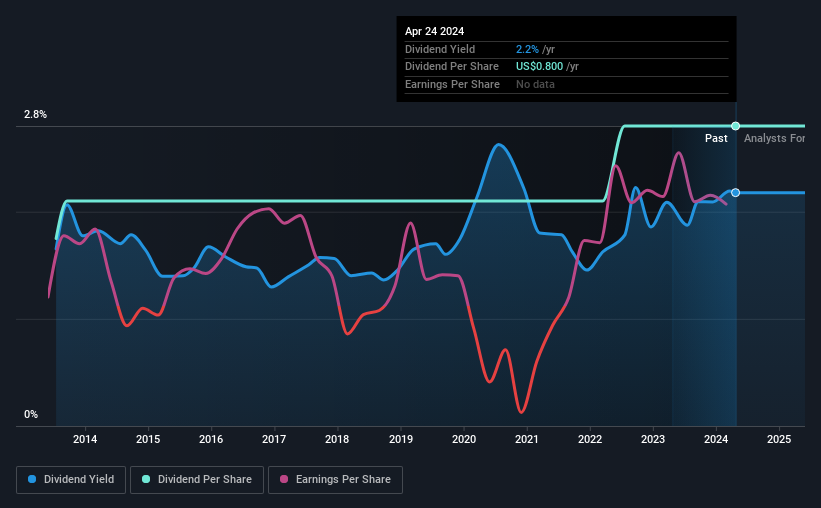Scholastic Corporation (NASDAQ:SCHL) Looks Like A Good Stock, And It's Going Ex-Dividend Soon
Scholastic Corporation (NASDAQ:SCHL) is about to trade ex-dividend in the next 3 days. The ex-dividend date is one business day before a company's record date, which is the date on which the company determines which shareholders are entitled to receive a dividend. The ex-dividend date is important as the process of settlement involves two full business days. So if you miss that date, you would not show up on the company's books on the record date. This means that investors who purchase Scholastic's shares on or after the 29th of April will not receive the dividend, which will be paid on the 17th of June.
The company's next dividend payment will be US$0.20 per share, on the back of last year when the company paid a total of US$0.80 to shareholders. Based on the last year's worth of payments, Scholastic has a trailing yield of 2.2% on the current stock price of US$36.73. Dividends are a major contributor to investment returns for long term holders, but only if the dividend continues to be paid. We need to see whether the dividend is covered by earnings and if it's growing.
Check out our latest analysis for Scholastic
Dividends are typically paid from company earnings. If a company pays more in dividends than it earned in profit, then the dividend could be unsustainable. That's why it's good to see Scholastic paying out a modest 47% of its earnings. A useful secondary check can be to evaluate whether Scholastic generated enough free cash flow to afford its dividend. The good news is it paid out just 19% of its free cash flow in the last year.
It's encouraging to see that the dividend is covered by both profit and cash flow. This generally suggests the dividend is sustainable, as long as earnings don't drop precipitously.
Click here to see how much of its profit Scholastic paid out over the last 12 months.
Have Earnings And Dividends Been Growing?
Businesses with strong growth prospects usually make the best dividend payers, because it's easier to grow dividends when earnings per share are improving. Investors love dividends, so if earnings fall and the dividend is reduced, expect a stock to be sold off heavily at the same time. It's encouraging to see Scholastic has grown its earnings rapidly, up 40% a year for the past five years. Scholastic is paying out less than half its earnings and cash flow, while simultaneously growing earnings per share at a rapid clip. Companies with growing earnings and low payout ratios are often the best long-term dividend stocks, as the company can both grow its earnings and increase the percentage of earnings that it pays out, essentially multiplying the dividend.
Another key way to measure a company's dividend prospects is by measuring its historical rate of dividend growth. Scholastic has delivered 4.8% dividend growth per year on average over the past 10 years. Earnings per share have been growing much quicker than dividends, potentially because Scholastic is keeping back more of its profits to grow the business.
The Bottom Line
Should investors buy Scholastic for the upcoming dividend? Scholastic has been growing earnings at a rapid rate, and has a conservatively low payout ratio, implying that it is reinvesting heavily in its business; a sterling combination. It's a promising combination that should mark this company worthy of closer attention.
Want to learn more about Scholastic? Here's a visualisation of its historical rate of revenue and earnings growth.
Generally, we wouldn't recommend just buying the first dividend stock you see. Here's a curated list of interesting stocks that are strong dividend payers.
Have feedback on this article? Concerned about the content? Get in touch with us directly. Alternatively, email editorial-team (at) simplywallst.com.
This article by Simply Wall St is general in nature. We provide commentary based on historical data and analyst forecasts only using an unbiased methodology and our articles are not intended to be financial advice. It does not constitute a recommendation to buy or sell any stock, and does not take account of your objectives, or your financial situation. We aim to bring you long-term focused analysis driven by fundamental data. Note that our analysis may not factor in the latest price-sensitive company announcements or qualitative material. Simply Wall St has no position in any stocks mentioned.

